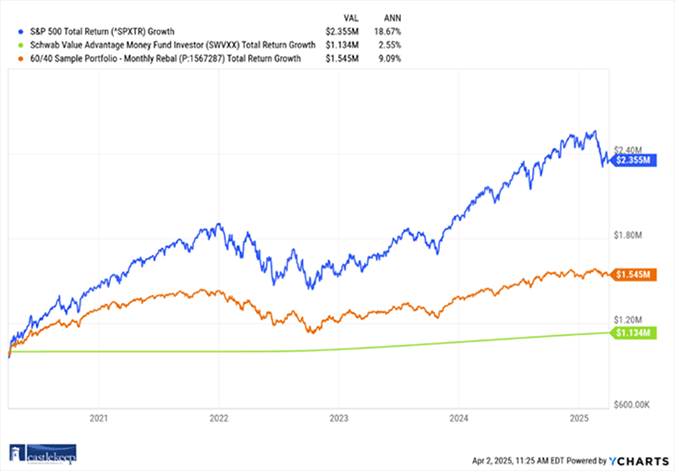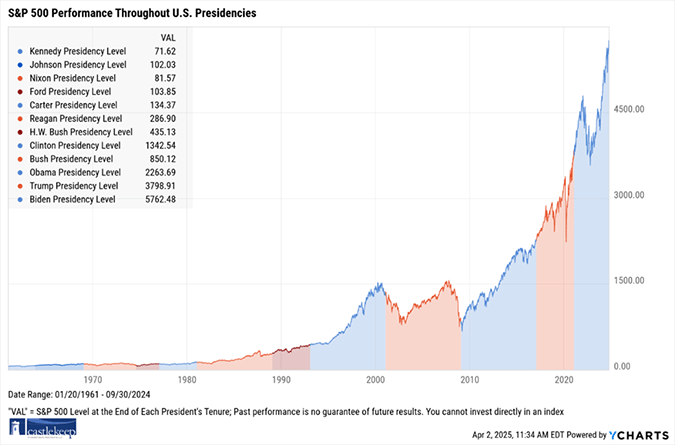CKBlog: The Market
Thursday, April 03, 2025
Trump Tempting You to Sell?
by Steve Haberstroh, Partner
Trump took office in a surprising victory.
The US economy had never been larger. The US stock market was at all-time highs. Inflation was under control.
Russian influence permeated headlines with many fearing President Trump would cozy up to Putin. The specter of tariffs spooked business leaders and global financial markets. Sweeping tax reform was on the agenda with many concerned that billionaires would benefit more than bar tenders. A government shut down loomed.
Investors, concerned about the political and economic environment, asked the question, “Should I get out now until the dust settles?”
Sound familiar?
It was January 2017 and Donald Trump just took office as President for the first time.
Despite the concern, what followed from his inauguration day through the of March this year was the S&P 500 Index compounding at 13.63% per year for eight years (including President Biden’s administration), nearly doubling the value of an investment in a basket of the 500 largest US stocks.
But here we are again. Facing an unsettling, yet somehow familiar time.
As a Fiduciary, I and our colleagues have been presented with the question almost daily. We are also human, so we understand the anxiety and temptation to sell out until the “all clear” signal appears. So why don’t we advise clients to do just that?
Trump 1.0 and Forward Returns
We acknowledge that much of Trump 1.0 differed from where we sit in Trump 2.0 today. However, as we described in the first four paragraphs of this post, today feels like more of the same.
No matter your political affiliation, we can all agree President Trump is an unconventional politician and is disruptive to markets and world order. But does that mean you’d be better off on the sidelines in the comfort of cash? After all, high-yielding cash can pay north of 4% in interest today.
Try to put yourself back in 2017 with the former reality tv star and real estate developer leading our nation. Do you recall considering getting out of the market? If so, you weren’t alone.
What if by March of 2017 you took action and decided to go to money market funds for your portfolio?
Money market funds at the time were paying less than 1%. Yields eventually grew to north of 4% after the Fed raised rates in 2022 to combat inflation. The annualized yield of Schwab’s money market fund (ticker SWVXX) from March 31st, 2017 to March 31st, 2025 has been: 2.21%. The return would have been eaten away by inflation.
What if instead, you invested in the S&P 500 Index or a diversified portfolio of 60% S&P 500 Index and 40% Bloomberg US Aggregate Bond Index rebalanced quarterly?
By March 31st, 2025, your $1 million would have been worth the following in the three scenarios listed above:

Was going to cash the right call (green)? Or would you have been better off staying the course, resisting the urge to time the market based on political headlines (blue or orange)?
It’s Not About Trump
Despite what we are told online and on cable channels, the market will care very little about President Trump over time. He wouldn’t be alone. Your experience as investor during the Clinton Administration had nothing to do with President Regan. The political agenda of the President George H.W. Bush Administration in the early 1990s had virtually zero impact on the stock market activity during President Obama’s reign from 2009-2017.
So why should we let the current President’s agenda force our hand today about where our portfolio may be 3, 4, or 10 Presidents from now?
To drive this post home, see the below chart depicting the US stock market over the last twelve presidents. The only trend I see here is stocks have always driven higher over the long term.
It may take a couple of administrations to recover from dramatic sell-offs, but there has never been a rolling 20-year period where the S&P 500 Index delivered a negative return for buy and hold investors.

Volatility Brings Opportunity
The reality is that investors face more options than merely going all in or getting all out of stocks. Times like today bring varying impacts on geographies, sectors, and individual companies. From time to time, we will act to take advantage of what we perceive as opportunities.
This post isn’t to advise completely ignoring market movements all together. In fact, we believe that a prudent investor should re-evaluate existing positions and potentially add positions that have been unduly hit by the market’s “risk off” sentiment.
At CastleKeep, we have done just that for most clients. We drilled down on existing positions, testing our theses. Over the last several weeks for certain discretionary portfolios, we exited, added to and established new positions in several securities depending on portfolio objectives.
Betting on American Dynamism
Since CastleKeep’s founding 25 years ago, we have lived through four serious events which led to very painful outcomes for stocks over the short term. Whether it was the Dotcom Bubble bursting, the tragic events of September 11th, 2001, the Financial Crisis in 2008-2009, or the Covid Pandemic in 2020-2021, in every case, it paid to remain patient ... and invested in a high qualified diversified portfolio of productive assets.
We recognize there have been skilled (lucky?) traders who have successfully timed markets during volatile times. But those folks either do not manage money for others, have retired to a tropical island somewhere, or were eventually humbled by Mr. Market. It is tempting, but we feel timing the market is a fool’s errand.
Politicians come and go. But the dynamism of the American Economy has never been defeated. So why try to fight against it by periodically sitting on the sidelines?
I am reminded of the 2018 Berkshire Annual Meeting. Warren Buffett and Charlie Munger took the stage in front of 40,000 shareholders. I was one of them. After briefly reviewing the previous quarter’s operating results, Mr. Buffett told the story of the first investment he ever made. It was March, 1942 and the US was in the midst of the Pacific War. Little Warren was 12 years young.
He went on to tell the story of how he asked his father to buy three shares of Cities Service for $38.25 per share for his own account. Four months later, he sold his shares at $40 pocketing a total profit of $5.25. Young Warren, influenced by the political environment and thinking he was clever, sold too soon. City Services was later acquired for $200 per share.
What followed at the 2018 meeting was a lesson we can all find useful today. Trying to time the market based on geo-political headlines is not a productive use of an investor’s time.
Find an investment game plan that works for your objectives. And stick to it.
Emphasis in bold is mine.
Warren Buffett, May 5th, 2018:
None of that counts at all, really, in a lifetime of investing. What counts is having a philosophy that you’ve—that you stick with, that you understand why you’re in it, and then you forget about doing things that you don’t know how to do.
You can read the transcript and see the video using the below link. The segment from the meeting described above starts in the sixth minute of the video.
https://buffett.cnbc.com/video/2018/05/05/morning-session—2018-berkshire-hathaway-annual-meeting.html
That story has stuck with me ever since. Warren Buffett is probably overquoted (I am guilty of it) and it is not just due to his track record as an investor. He has a unique ability to distill the complex into the simple. We live in complex times. I am not saying it is easy, but it is precisely now when it pays to keep things simple.
So, as you flip through cable news tonight and one of the paid political “contributors” instills fear and causes you to question why you are invested, play the clip of Buffett or read the transcript. It may help you rest easy.
Sincerely,
Steve Haberstroh
Partner
CastleKeep Investment Advisors LLC
April 3rd, 2025
Here is a PDF of this entry: Trump Tempting You To Sell Stocks
IMPORTANT DISCLOSURES
- Registration with the SEC should not be construed as an endorsement or an indicator of investment skill, acumen or experience.
- Investments in securities are not insured, protected or guaranteed and may result in loss of income and/or principal. Historical performance is not indicative of any specific investment or future results.
- Investment process, strategies, philosophies, portfolio composition and allocations, security selection criteria and other parameters are current as of the date indicated and are subject to change without prior notice.
- This communication is distributed for informational purposes, and it is not to be construed as an offer, solicitation, recommendation, or endorsement of any particular security, products, or services. Nothing in this communication is intended to be or should be construed as individualized investment advice. All content is of a general nature and solely for educational, informational and illustrative purposes.
- This communication may include opinions and forward-looking statements. All statements other than statements of historical fact are opinions and/or forward-looking statements (including words such as “believe,” “estimate,” “anticipate,” “may,” “will,” “should,” and “expect”). Although we believe that the beliefs and expectations reflected in such forward-looking statements are reasonable, we can give no assurance that such beliefs and expectations will prove to be correct. Various factors could cause actual results or performance to differ materially from those discussed in such forward-looking statements. All expressions of opinion are subject to change. You are cautioned not to place undue reliance on these forward-looking statements. Any dated information is published as of its date only. Dated and forward-looking statements speak only as of the date on which they are made. We undertake no obligation to update publicly or revise any dated or forward-looking statements.
- Views regarding the economy, securities markets or other specialized areas, like all predictors of future events, cannot be guaranteed to be accurate and may result in economic loss of income and/or principal to the investor.
- Any references to outside data, opinions or content are listed for informational purposes only and have not been verified for accuracy by the Adviser. Third-party views, opinions or forecasts do not necessarily reflect those of the Adviser or its employees.
- Unless stated otherwise, any mention of specific securities or investments is for illustrative purposes only. Adviser’s clients may or may not hold the securities discussed in their portfolios. Adviser makes no representations that any of the securities discussed have been or will be profitable.




